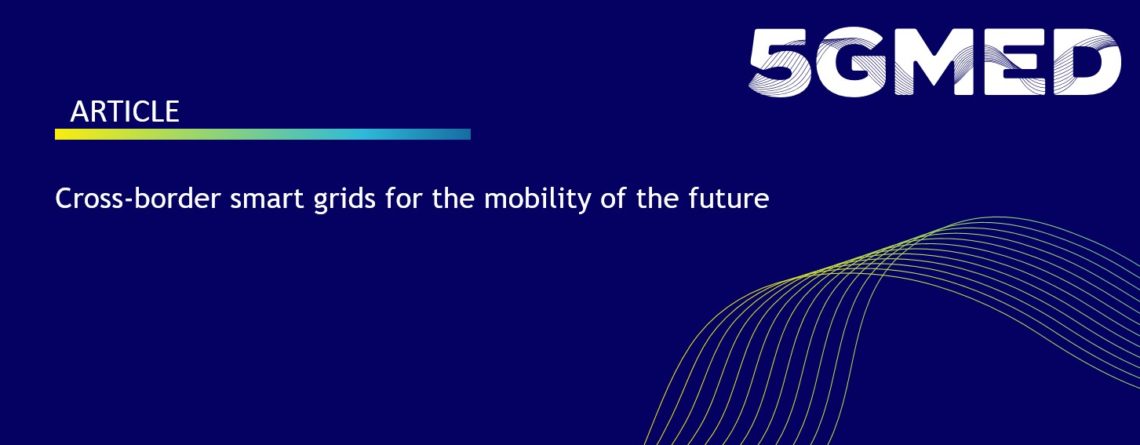Cross-border smart grids for the mobility of the future
The 5GMED project develops 5G connectivity solutions for rail and highways in the Mediterranean cross-border corridor
The 5GMED project is carrying out four pilot projects, one in the railway field and three more in the Mediterranean corridor motorway, with the aim of providing a model for the sustainable deployment of smart networks for the connected and automated mobility of the future in Europe. This section of the border between France and Spain is strategic, since it supports 55% of the road traffic between the Iberian Peninsula and the rest of Europe, as well as 65% of the rail traffic between both sides of the Pyrenees.
5GMED deploys an infrastructure that provides advanced connectivity services in a scalable and reproducible manner across transportation routes, and tests a wide range of technologies applied to mobility, including on-board and infrastructure sensors, 5G networks, and Artificial Intelligence (AI). Specifically, the use cases developed at 5GMED focus on remote driving of autonomous vehicles, advanced traffic management, high-speed connectivity services on rail during the cross-border shift, and high-quality infotainment services (such as augmented reality and 360º videos) for the connected vehicle.
To analyze the importance of 5GMED for the mobility of the future, Diálogos at La Vanguardia, a Spanish newspaper, with the collaboration of Cellnex, the coordinator of 5GMED, organized a session with some of the 5GMED partners:
- José López Luque, Innovation Project Manager at Cellnex and 5GMED Project Coordinator.
- Francisco Vázquez Gallego, V2X Research Line Manager at i2CAT and 5GMED Technical Director.
- Judit Bastida, Innovation Project Manager at Cellnex and 5GMED Network Deployment Leader.
- Manuel Alfageme, Head of Innovation Systems at Comsa.
- Eduard Martín, CIO at Mobile World Capital.
- Xavier Daura, Toll Road Innovation Manager at Autopistas Abertis.
- Rita Almela, Founder at 101 Ventures.

5G deployment with cutting-edge technologies in areas with little connectivity
José López Luque highlighted the relevance of “giving continuity to services between countries and supporting the deployment of 5G” in areas that currently have even less connectivity. Additionally, he pointed out that “the role of companies like Cellnex Telecom, acting as a ‘neutral host’, will help boost the deployment of 5G coverage in areas where traditional operators currently do not reach”.
Judit Bastida added that 5GMED will demonstrate how “the mobility of the future can be implemented with different types of cutting-edge technologies that are based on 5G networks, such as ‘edge computing’, which makes it easier to connect many devices”. The expert also stressed that “the deployment of 5G is tested in a controlled environment to subsequently implement it”.
However, one of the technological challenges is found precisely in the section of the border. Specifically, the great challenge lies in “reducing service interruption times when crossing the border”, which can be decisive both in the case of the connected and autonomous vehicle and the railway, as explained by the Technical Director of 5GMED, Francisco Vázquez Gallego.
Cooperative, connected and automated mobility to benefit road safety and sustainability
“Innovation is a strategic and transversal pillar of Autopistas Abertis through which we project new solutions for the mobility of the future”, assured the Innovation Manager of Autopistas, Xavier Dura. “The future of infrastructures depends on its digitization, and 5GMED provides all the ingredients to deploy different services for a more cooperative, connected and automated mobility. The three use cases on highways will serve to investigate the application of technologies in infrastructures that will benefit road safety and sustainability”, he explained.
From autonomous driving to high-quality infotainment
On the railway, “the passenger will benefit from unlimited access to the Internet for professional use and entertainment, and the rail transport operator will obtain lower costs for better and new services for its operation”, stressed the Head of Innovation Systems at Comsa, Manuel Alfageme. “The economic viability and attractiveness of the railways will improve with the new connectivity to the train developed,” he added.
The CIO of Mobile World Capital, Eduard Martín, celebrated the potential of 5GMED to “generate added value for society thanks to the commitment to technology transfer”, which will allow “creating new opportunities that feed back into the exploitation phase of the project”.
Collaboration between the ecosystem and the different actors is “key” to “add knowledge, promote technology transfer, innovate and develop better advanced technologies, create better solutions, attract talent and have a positive impact on society, particularly in mobility and connectivity”, agreed Rita Almela, founder of 101 Ventures.
5GMED Partners round table in quotes
- José López Luque: “5GMED will allow continuity of services between countries and support the network deployment”.
- Francisco Vázquez Gallego: “The challenge we have ahead of us is to reduce service interruption times when crossing borders”.
- Judit Bastida: “The mobility of the future will be implemented by combining different types of very advanced technologies”.
- Manuel Alfageme: “Services for passengers, economic viability and attractiveness of the railways will improve with the new developed connectivity”.
- Xavier Daura: “The application of technologies will benefit safety on roads and sustainability”.
- Eduard Martín: “The commitment we make to technology transfer will generate added value for society.”
- Rita Almela: “The close collaboration between the ecosystem is key to add knowledge and attract digital talent”.
This article was originally published in the Spanish newspaper La Vanguardia.


